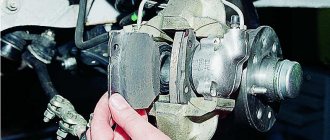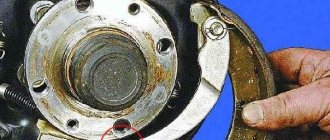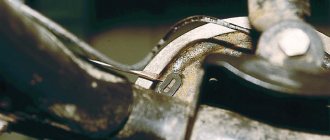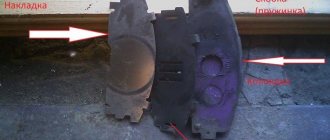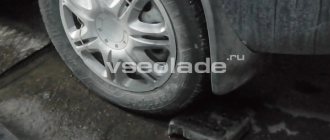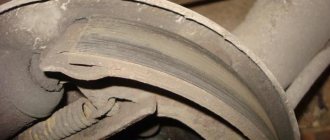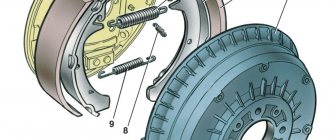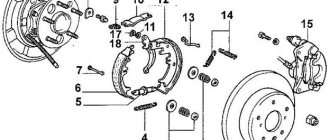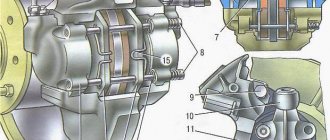Working principle of brake pads
This mechanism is attached to the central part of the wheel, called the hub, and is something between the wheel itself and the hub. This arrangement allows the blocks to perform their function of reducing vehicle speed. Disc-type mechanisms are located on the front of the rotating axis, while drum-type mechanisms are located at the rear.
The drum mechanism acts on the pads, maintaining them in a compressed state, which is achieved thanks to two special springs. The upper part of the pads fits into the grooves of the brake cylinder, while the lower part fits into the hub.
- When you press the brake pedal, pressure appears on the pistons, which leave the cylinder.
- They push the pads, overcoming the resistance provided by two springs.
- Due to the friction that occurs between the drum and the pads, the drum slows down, which in turn leads to a decrease in the rotation speed of the wheel.
- The more pressure on the brake pedal, the more intense the friction, and the faster the speed drops.
When working with disk-type mechanisms, a slightly different operating principle is observed.
Diagnosis of brake pad wear
As you already understand, brake pads are the main element in the braking system. And they are the ones who ensure the safety of the car while driving. However, like any other spare part, they have to be changed from time to time.
Due to frequent interaction with other parts that are located too close to them (drum, disk), friction occurs between them and special friction linings. The latter, in turn, wear out, and there is a need to replace them.
To determine the degree of brake pad wear, pay attention to the following signs:
- While braking and until the vehicle comes to a complete stop, you hear a high-pitched squealing sound. It is this that indicates that the surface of the linings has completely worn out. Consequently, the drum is now in direct contact with the metal.
- If you notice that your vehicle starts to brake too hard or takes a long time to slow down, this also indicates that there is empty space between the worn out linings and the drum. Moreover, you need to apply much more effort when pressing the gas pedal. Additional effort when pressing provokes a slowdown in the braking process. In the case of a complete absence of friction linings, braking will be harsh, since the friction between the pad and the disc will increase. This, in turn, will cause damage to the drum or disc itself.
- If you notice a vibration in the brake pedal, this is also a sign of a problem. This is explained by the fact that the pads are worn unevenly.
If you notice at least one of the above signs, do not delay repairs.
2283-14-03-01
To do this, use a slotted screwdriver to rotate the ratcheting nut of the mechanism for automatically adjusting the gap between the pads and the drum through the threaded hole in the brake drum, thereby reducing the length of the spacer bar.
To do this, use a slotted screwdriver to rotate the ratcheting nut of the mechanism for automatically adjusting the gap between the pads and the drum through the threaded hole in the brake drum, thereby reducing the length of the spacer bar.
What affects the reliability of the braking system?
It should be noted that there are points that have a great impact on the reliability and service life of brake pads.
These include the following points:
- How and what are the pads made of?
- Driver's driving style: aggressive, moderate.
- Quality of roads.
- Climate and time of year.
- Lifetime.
As mentioned earlier, the car’s braking system requires the most responsible care. You shouldn't skimp on it. Choose only high-quality spare parts from trusted manufacturers.
Moreover, if the pads you choose do not fit the dimensions of your car, do not under any circumstances attempt to modify them.
Understand that any impact in the future can disrupt the progress of their work and lead to irreversible consequences, the least of which will be the rapid failure of the pads themselves.
It is necessary to check the condition of the brake mechanism every 10 thousand km. Factors indicating the need to replace parts are:
- If the thickness of the residual friction layer is 2 mm or less.
- If there is damage on the pads that was not obtained naturally.
- If the mechanism has chips, cracks, grooves and irregularities.
Adjusting car brakes
The brake system may require operational adjustments. For this:
- Raise either the axle or the wheel of the car.
- Rotate the squares of the brake levers to the right until the wheel begins to slow down slightly.
- Then they turn the square back.
- Set a gap of 0.3-0.4 mm between the drum and the block lining. To avoid mistakes, the gap is measured with a special feeler gauge, passing it in the middle zone of the lining - through the “window” in the drum.
- After adjusting all the wheels of the car, they test the system either on the machine or on the move.
After the drum is repaired, the pads are replaced and the linings are re-riveted, they turn to complex adjustment using eccentric support fingers. Follow the algorithm:
- Adjusting the brake lever square pads according to the instructions given above.
- Release the nuts of the support pins, after which they turn them towards each other, thereby pressing the pads against the drum as far as possible. It is in this position that the finger nuts are tightened.
- Achieve a normal gap between the drum and the linings.
- At the end of the adjustment procedure, they test how easily the wheel rotates.
How to replace front brake pads
Replacing the front pads is easier than doing the same with the rear ones due to their design features.
The algorithm of actions is as follows:
- Place the car on a flat surface.
- Set the vehicle's parking brake. Make sure it does not roll back when changing position.
- Loosen the bolts that secure the wheels.
- Use a jack to raise the desired part of the car.
- Now you can remove the wheel from the hub and assess the condition of the brake system.
- If there is severe wear, unscrew the caliper bolt and carefully remove the caliper itself from the disc.
- Now you can remove the pads.
Before replacing the part, be sure to lower the piston completely into the cylinder. This is done so that the caliper can be reinstalled in its place.
Since the caliper is made of aluminum, you can apply force to it without damaging it.
Now you can install new pads, put the caliper and wheel back in place, and return the car to its previous position.
Assembly and adjustment of hydraulic brakes
The procedure is carried out in the following sequence:
- A pair of adjusting eccentrics are inserted into the protective disk, after which springs are put on them from the outer part, and then the nuts are tightened.
- Assemble the wheel cylinder of the brake system. To do this, they put a pair of cuffs, a pair of pistons, a spring in it, put on sealing covers, and install thrust block pins.
- Rotate the cylinders towards the protective discs.
- Install the pads: secure them with brackets to insert the support pins.
- Lock nuts with spring washers are screwed onto the support pins from the reverse side.
- Put on the coupling spring of the pads.
- The protective disk is attached: for the rear wheel - to the flanges of the axle housings, for the front wheel - to the flanges of the steering axles.
- Install the brake system drum.
- Excess air release valves are screwed into the wheel cylinder from the side of the protective disc.
- Connect the hydraulic drive hose fittings.
To make adjustments before use, you need to:
- Raise the front wheel using a jack.
- While rotating this wheel forward, also rotate the front eccentric forward - until the very beginning of braking.
- Then that eccentric is turned in the opposite direction to achieve free wheel rotation.
- The rear pad is adjusted - to do this, the second eccentric is rotated back, also rotating the wheel back.
- All other wheels are adjusted according to the instructions given.
- Test the brake system while driving the car. If everything is done correctly, the car will come to a complete stop if the driver depresses the brake pedal approximately ½ of its possible travel.
- Another option for checking the brake system is at a special GARO installation, where (depending on the model) two or four wheels are checked at once. At the same time, they rely on data from the dynamometer, comparing the actual indicators with the factory ones.
How to replace rear brake pads
If there is a drum-type mechanism, replacing the above-mentioned parts becomes much more difficult.
- You need to jack up the car and remove the wheel. To remove the drum, open and unscrew the nut that is attached to it. After this, the part is carefully removed from the hub. Be sure to pay attention to the bearing, which, if there is a parking brake, must be removed.
- Now you can start removing the springs. This action will require a lot of effort, as it creates significant pressure. After this, the clamps are removed from the pads. Now it seems possible to remove the pads themselves.
- As in the case of the front part of the car, the piston should also be recessed here.
- New elements are installed, fixed using clamps and springs, and the bearing is returned to its place.
- Now you can put the drum and wheel back in place.
After this, you need to take into account the fact that you cannot replace either the rear or front pads separately. Replacement must be done immediately and on all wheels.
DSC_9301
The spacer bar is a rather complex mechanism, which, if the elements are damaged or significantly corroded, is best replaced.
If the condition of the spacer bar is satisfactory, then it should be washed in any solvent and a thin layer of grease should be applied to the threads. The spacer bar is a rather complex mechanism, which, if the elements are damaged or significantly corroded, is best replaced. If the condition of the spacer bar is satisfactory, then it should be washed in any solvent and a thin layer of grease should be applied to the threads.
